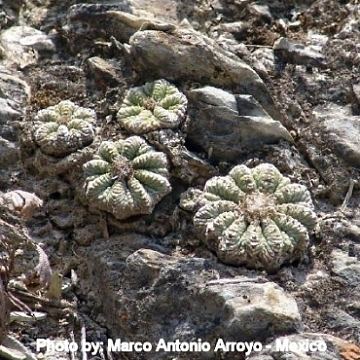Family Cactaceae Higher classification Cacteae | Scientific name Aztekium Rank Genus | |
 | ||
Lower classifications Aztekium ritteri, Aztekium hintonii | ||
Pereskiopsis grafting cactus planting graft aztekium lophophora san pedro
The genus Aztekium contains three species of small globular cactus. Discovered in 1929 by F. Ritter, in Rayones, Nuevo León, Mexico, this genus was thought to be monotypic (with Aztekium ritteri) until a second species (Aztekium hintonii) was discovered by George S. Hinton, in Galeana, Nuevo León in 1991. A further species, Aztekium valdesii, was discovered in 2011 by M.A. Alvarado Vázquez in the Sierra Madre Oriental mountains of Nuevo León; the name was formally published in 2013, although as of September 2013 the name is not accepted by secondary sources such as The Plant List.
Contents
- Pereskiopsis grafting cactus planting graft aztekium lophophora san pedro
- Aztekium ritteri rare mexican cactus grafted
- Description
- Etymology
- Distribution
- Cultivation
- Phytochemistry
- References

Aztekium ritteri rare mexican cactus grafted
Description

Aztekium ritteri is a small plant (around 20 mm wide), with 9 to 11 ribs, which typically have transverse wrinkles. Its color varies from pale green to grayish-green. The center of the cactus contains a lot of white wool. Flowers are small (less than 10 mm wide), with white petals and pinkish sepals. The plants bear small pinkish berry-like fruits. A. hintonii is larger, to 10 cm in diameter, 10 to 18 grooved ribs, flowers magenta to 3 cm. It grows only on gypsum. A. valdesii is up to 6 cm in diameter, has 5 grooved ribs, and has seeds notably different from other two Aztekium species.
Etymology

Its name is dedicated to the Aztec people, due to the resemblance between the plant's shape and certain Aztec sculptures.
Distribution

This genus is found only in the state of Nuevo León in Mexico. It was estimated that there were in the order of tens of millions of plants of A. hintonii, and at present most of its range is pristine. Though A. ritteri has been collected for decades and there has been destruction of its habitat, the number of plants in habitat is several million.
Cultivation

These species grow extremely slowly, taking around two years to attain a diameter of 3 mm. They are usually propagated by seeds.
Phytochemistry
The plants contain the following compounds:
